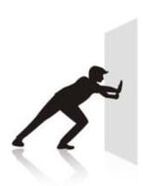The Premise
The general idea is that all surfaces flex when they impart a normal force but for rigid surfaces like a brick wall, it's impossible to see it by just staring at the wall when someone pushes. This demo uses a rod attached to the wall that rolls a small dowel to turn a mirror and deflect a laser point when the wall is pushed. It's a pretty cool set up to walk students through and makes for an awesome introduction to the topic that all students can see (and even try for themselves). Materials
SetupThere are several different ways that you could get this demo to work. In the video above, I used a wall and a table and in Marc's post, he uses a beam and a chair. Just make sure that the laser and mirror are on surfaces that are not attached to (and moving with) the wall that you are pushing on and you should be good to go. I also recommend playing around with your laser and mirror set up so that the laser point ends up in a place that the entire class can see. Even though this apparatus is in the corner of my classroom, the point that gets deflected is on the ceiling in the very middle of the room. Discussion QuestionsI do this in my classroom as a full class introduction but there are still some opportunities for discussion in groups as we work through this demonstration.
ExtensionIf students really want to get into it, they can use the deflection of the laser, distance to the ceiling, and the radius of the dowel to calculate how much the wall actually moved ;) See this article for more details. CLICK HERE FOR MORE DEMOSClick for more Waves resources ⬇
Comments
|
Joe CossetteFather, Physics Teacher, Knowles Fellow, Friend, Techie, and Musician Blog Posts |



 RSS Feed
RSS Feed

